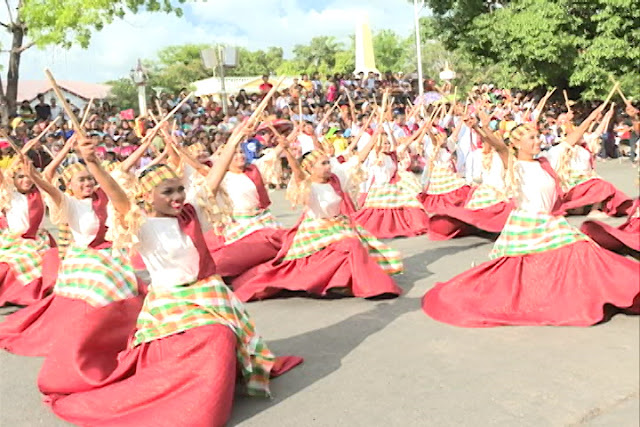My Igorot Learning
Photo Courtesy: yahoo.com
The kid in me always reminds me how my fascination started to
“happy” and “colorful” visitors who often I see during Christmas season. I described them as “happy” because they
always wear a smile while playing an instrument, and “colorful” because of
their costumes. I remember asking my mother who are they and answer me once
“bisita tayo isuda nga Igorot nga umay maki-paskua”. Since then the term
“Igorot” raises curiosity in me. When I was in my grade school I remember a
discussion telling that the Igorot are the people of the Cordillera, back then
I was not even familiar to Cordillera. The simplest explanation my teacher told
me then is Baguio City is Cordillera.
My learning about Igorot became more understandable during my
first year in high school. At this time I learned that term Igorot is an old
Tagalog which means “people from the mountains” and was later used to generally
refer to all mountain tribes from the Cordilleras. Our discussion then also
includes the diverse culture of the Igorot – from their practices, traditions
and languages even their dances, literature, music and chants. I got also an
answer to my question back then to why they are wearing something different
when they are visiting our place for carolling; it is their native clothing
that they wear to symbolize their ethnicity, something that they are proud of.
My appreciation to the Igorot becomes personal every time my
uncle and his wife visit us. My uncle’s wife is an Itneg from Sallapadan, Abra
who is proud of being a Cordilleran – an Igorot. Every time they visit us they
would bring some of their agricultural products especially rice either the
white or the colour one. Jacob Maentz a photographer who wrote a blog entitled
People of the Mountains – Igorots of the Cordilleras described that “much of
the culture and life in the Cordillera revolves around rice”. Their planting to
harvest each period represents a time that is honoured and sacred in its own
way, thus making every single product they gave us more special. Maentz added
that “aside from rice cultivation there are numerous agricultural products
grown in Cordillera because of the altitude and cool and temperature”. Other
products such as vegetables are grown in abundance and are brought to lowlands
to be sold. Perhaps this is one reason why the forest, mountains and their
lands are significant resources to the life of the Igorot people because it is
in here that they can get something useful. Aside from farming, I have also
learned that hunting and fishing are also important parts of culture in the
Cordilleras that is often learned at early age. The ancestral domains of the
Igorots comprise their sacred places, burial and hunting grounds, some of which
still exist up to this date because of their continuing preservation of said
native landmarks.
Rice Terraces are common in the land of the Igorots.
Photo Courtesy: yahoo.com
Even up to this date I can still remember some Itneg words my
cousin taught me like “na-id” or nothing, “na-oy” or this and “atsidi” meaning
to go. But forgive me if I misspelled them as she only taught me how to speak
and what these words mean.
It is in my college years when I learned about the rituals
that the Igorot performs before planting and during harvest time as a sign of
thanksgiving, and these practices are being followed even at the present time.
The customs and traditions are being preserved and protected that most are now
being threatened by modernization.
Being employed as a television reporter made me discovered
the link of the Igorot to my province Ilocos Sur. Our province has fourteen
upland Indigenous Cultural Communities and nine lowland municipalities with
indigenous cultural communities. These cultural communities are inhabited by
Kankanaeys, Tinguians, Bago and some other tribes like Applain and Ibaloi that
are all considered Igorot. This became possible as the said cultural
communities are situated at the eastern part of the province or the Cordillera
where the boundaries with Abra, Mountain Province and Benguet. I have also done
several IP related stories such as the effectiveness of implementation in the
locality the Republic Act 8371 or the Indigenous Peoples Right Act (IPRA). This
was enacted to recognize, protect, and promote the rights of indigenous
cultural communities, and the embodiment of the rights and aspirations of
indigenous people in their right to ancestral domains, right to self-governance
and empowerment, social justice and human rights, and cultural integrity.
I can say that my learning about the Igorots is still in the
process, but basing from what I have learned, researched and even read I can
personally manifest that the Igorot are hardworking individuals with strong
belief in the preservation of culture and the promotion of their ethnicity. As Maentz
said “one of the unique aspects of life in the Cordilleras is that the Igorot
people are essentially a self-contained society running all aspects of life
from business to politics. He added that “unlike many of the other tribes or
indigenous communities in the country who have been extremely marginalized and
pushed to small pieces of their original land, the Igorot people generally have
maintained much of their land”.
Now, I am excited to discover new learning about the Igorot
people and their culture and eventually learn to personally practice the
culture I got fascinated since I was a kid.
References:
PRINT PUBLICATIONS
Khan, R.E. (2011). Media
and Culture. Anvil Publishing, Inc.
Mendez, I.M., et al. (2002). Panahon, Kasaysayan at Lipunan. Diwa Learnings Systems Inc.
National Commission on Indigenous Peoples Information Kit.
(2014)
INTERNET
Maentz, Jacob ().People of the Mountains – Igorots of the
Cordilleras. Retrieved from http://www.jacobimages.com/2013/05/igorots-cordilleras
Sagada-Igorot.com. Retrived from http://sagada-igorot.blogspot.com/2007/12/igorot-ethnic-groups.html
Tibaldo: Knowing and Understanding Igorot Culture.





Comments
Post a Comment